
1931-07-04 The Long Beach Life pg 6. Advertisement for the original Sportland with the price reduced to 25 cents per hour.
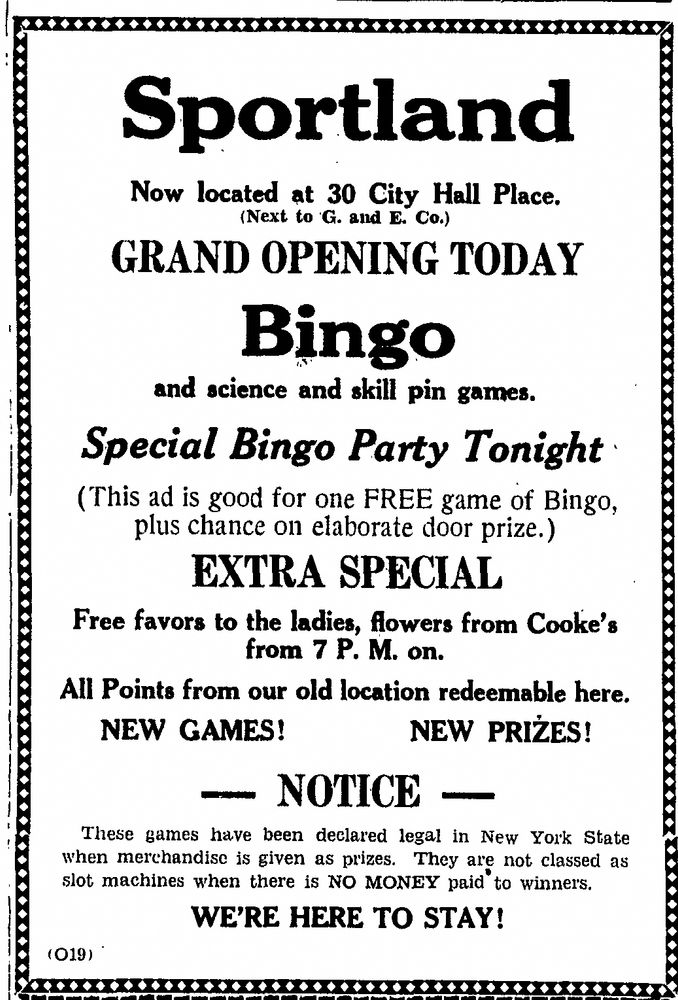
1935-10-19 Plattsburgh Daily Press pg 4. A later Sportland advertisement featuring pinball as one of the featured games.

1931-08-22 The Long Beach Life pg 8. A notice of the first Sportland visited by a Japanese Rolling Ball seller who plans to franchise the arcades in the South.
From a model reduced to 25 cents per entry and a constant variety of new games - eventually including pinball - the Sportland franchise was born.
There's still a lot more to find about this pre-War arcade boom. Just wanted to share some of the fascinating discoveries!
03.10.2025 22:05 — 👍 2 🔁 0 💬 0 📌 0

1931-08-01 The Long Beach Life pg 2. Profile on the Long Island Sportland emphasizing its variety; with a degraded photo of the location.

1931-07-25 The Long Beach Life pg 2. Info on a table baseball game championship held at Sportland.
More than that, the paper also provides insight on how they promoted the early locations: Through contests.
Like would happen with foosball and air hockey decades later, the original Sportland drew in customers by providing competitions for players to come test their skill.
03.10.2025 21:58 — 👍 2 🔁 0 💬 1 📌 0
Some follow-up research on the early Sportland arcades!
While the Hobby House was the prototype of the Sportland, we didn't know when the first location dubbed "Sportland" opened.
Thanks to the local Long Island newspaper, we can now answer that it first opened in July 1931.
03.10.2025 21:54 — 👍 5 🔁 1 💬 1 📌 0
Computer Quiz and the related Nutting machines were very well known throughout the 1970s, including to people at Atari.
When Nutting Associates was bought out by distributor Si Redd, the resulting Sircoma company was one of the pioneers of video poker.
01.10.2025 01:22 — 👍 0 🔁 0 💬 2 📌 0

1946-08-26 Cash Box pg 51. Woman poses with a graduation hat in front of a Telequiz machine.
We may never know the extent to which Telequiz was an obvious evolution or a highly influential coin-op game.
But next time you see a countertop quiz machine, spare a thought for the device that set the stage for commercial video games.
Time's up!
30.09.2025 22:56 — 👍 8 🔁 1 💬 1 📌 0

Console of the later model of the Quizzer by Training Devices Inc.
https://www.pinrepair.com/arcade/quizzer.htm

1968-12-14 Cash Box. Nutting Associates' booth at the 1968 MOA show, displaying Computer Quiz.
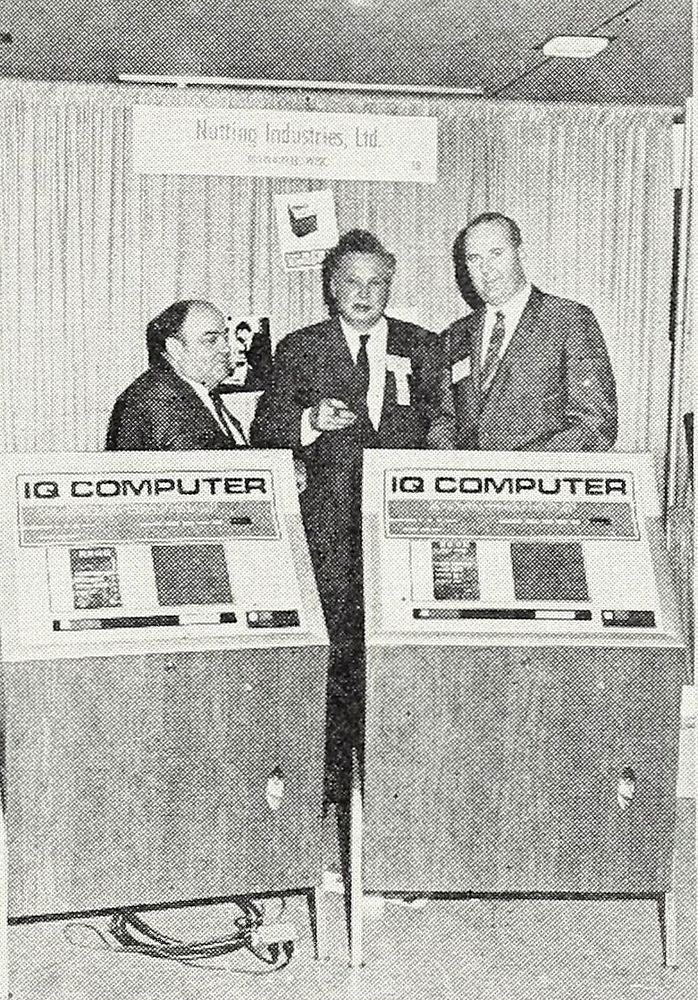
1968-11-02 Cash Box. Nutting Industries' booth at the 1968 MOA show with I.Q. Computer. In the middle is Mike Kogan, founder of Taito.
Telequiz was not a failure - nor was it totally alone. Training Devices followed up with the game Quizzer before they vanished.
The lack of written memory is a bit bizarre, but perhaps helps explain why Computer Quiz and I.Q Computer gained traction so quickly.
30.09.2025 22:54 — 👍 6 🔁 1 💬 1 📌 0

1968-07-11 Milwaukee Journal pg Part 2 19. David Nutting (L) and Harold Montgomer (R) stand with an I.Q. Computer machine.
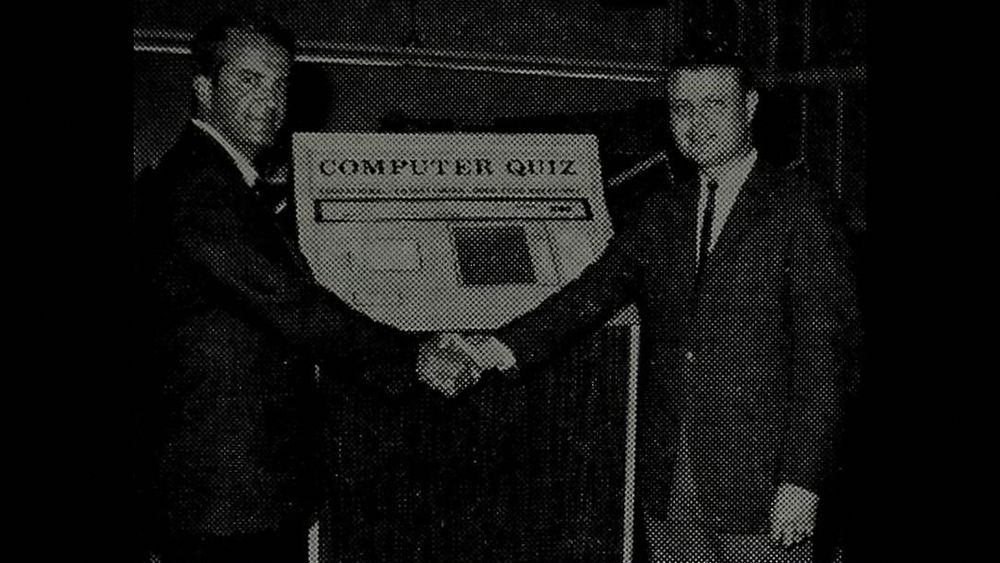
1968-05-18 Cash Box. Bill Nutting (L) shakes hands with a distributor over a Computer Quiz.

1950-06-03 Cash Box pg 30. People stand around an updated Telequiz machine at a trade show.
Not a single person interviewed from Nutting Associates or Nutting Industries have brought up this connection.
Even the coin-op magazines Cash Box and Billboard never brought up the similarities to this popular machine from less than two decades earlier.
30.09.2025 22:49 — 👍 5 🔁 1 💬 1 📌 0

Flyer for Computer Quiz.

1947-01-27 Cash Box pg 87. Advertisement for the original Telequiz, featuring the illustrations on the film.
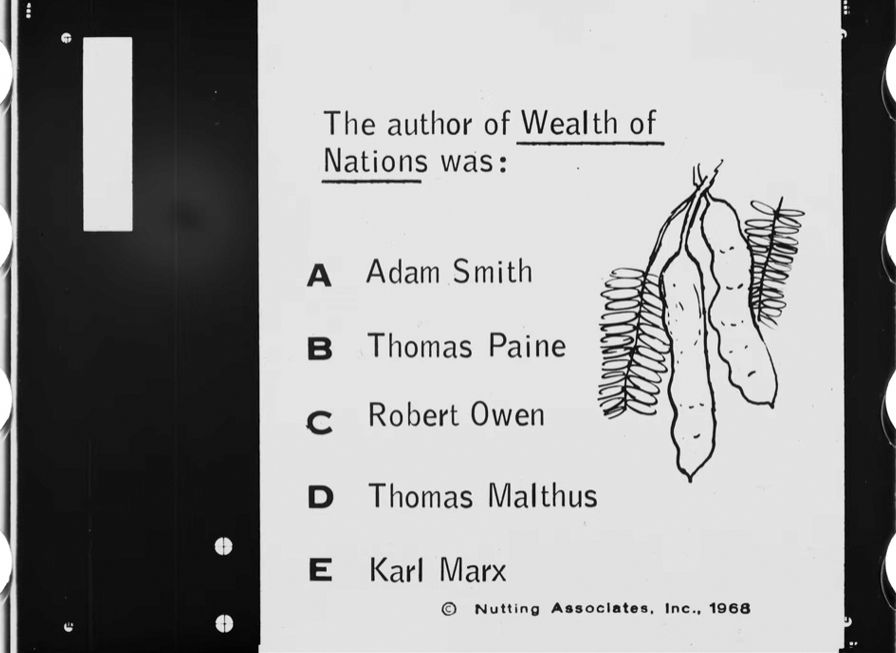
A scan of the film used in Computer Quiz from the Strong Museum of Play.
https://www.youtube.com/watch?v=1ROeUjrffAw

1947-07-28 Cash Box pg 38. Kids dressed up in graduation caps using the later version of the Telequiz, Quizzer.
Here's some startling parallels:
-Computer Quiz used the motif of the "graduating girl" in their advertisements; so did Telequiz.
-Training Devices operated mainly in Michigan and Wisconsin, as Nutting Industries would.
-The illustration style on Telequiz looks like those of the later machines.
30.09.2025 22:45 — 👍 4 🔁 1 💬 1 📌 0
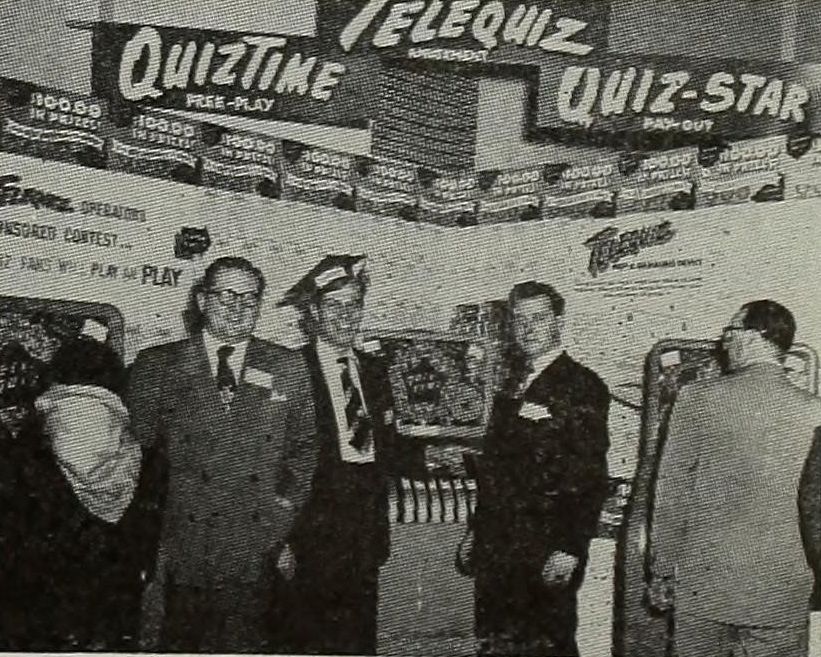
1949-02-05 Cash Box pg 21. Telequiz's reintroduction at the 1949 CMI show.

A red-tinted Telequiz 2.0 cabinet.
https://www.bidsquare.com/online-auctions/fine-estate-inc/amazing-telequiz-arcade-game-2139821

1948-11-13 Cash Box pg 25. Advertisement for the improved Telequiz machine.
This time the machine found its audience - an audience outside of both the fading arcade market and the rising trade in bars.
So what does Telequiz mean for the history of coin-op and even of the history of automated teaching machines at large?
30.09.2025 22:41 — 👍 5 🔁 1 💬 1 📌 0

1947-02-10 Cash Box pg 51. Telequiz shown at the 1947 CMI show in a hotel room.

1946-09-16 Cash Box pg 61. Projected manufacturing timeline of Telequiz and the complicated partnerships therein.
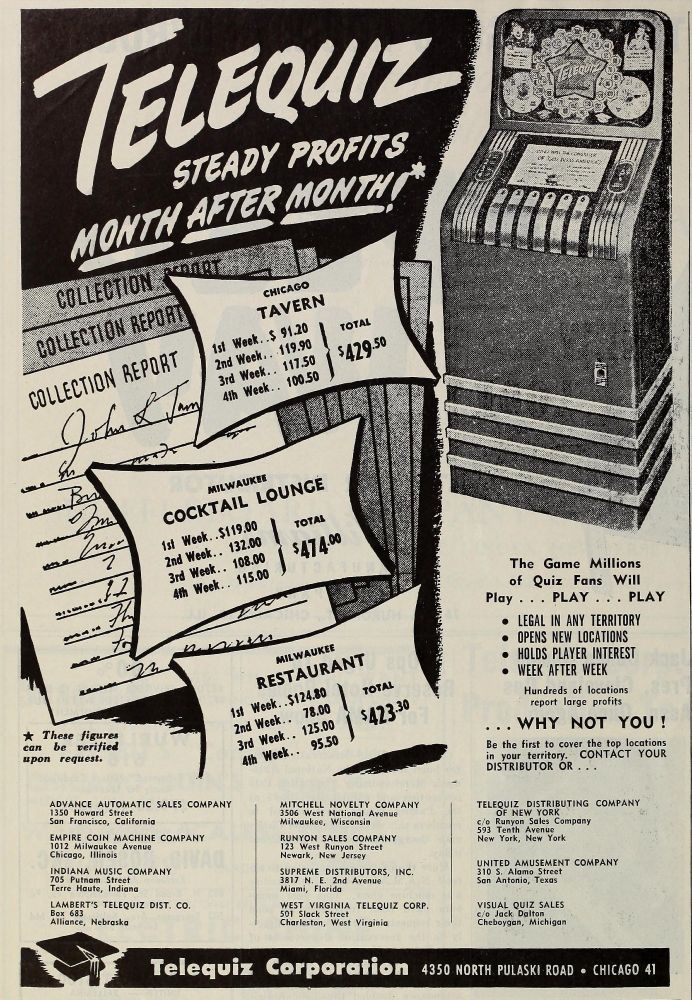
1948-10-09 Cash Box pg 30. Advertisement for the new model of Telequiz, with increased earnings and smaller floorspace.
However, the advanced technology of Telequiz delayed its manufacturing and created an $800 price tag. Hype dissipated when units didn't materialize.
In 1948 the product was rejiggered to be sleeker and introduced an upwardly-mobile base play price of 10 cents - for only $350.
30.09.2025 22:39 — 👍 4 🔁 1 💬 1 📌 0
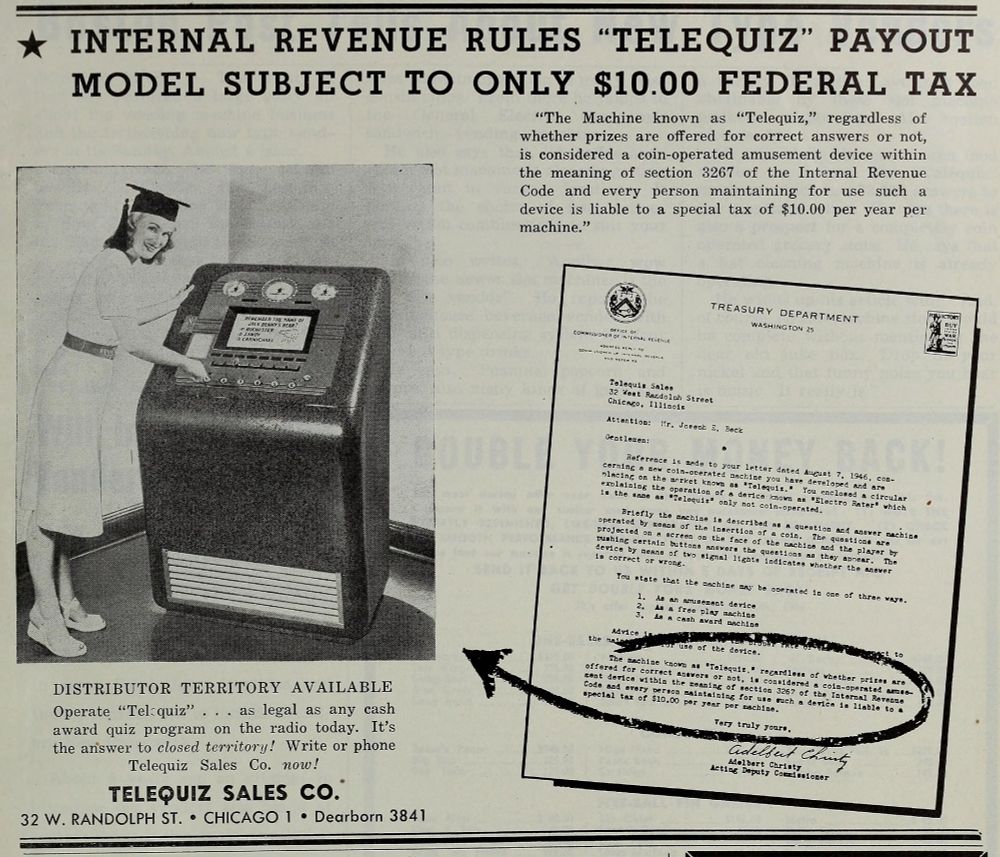
1946-08-26 Cash Box pg 54. Advertisement for Telequiz using a letter from the IRS regarding its tax refund status as a coin-operated device.
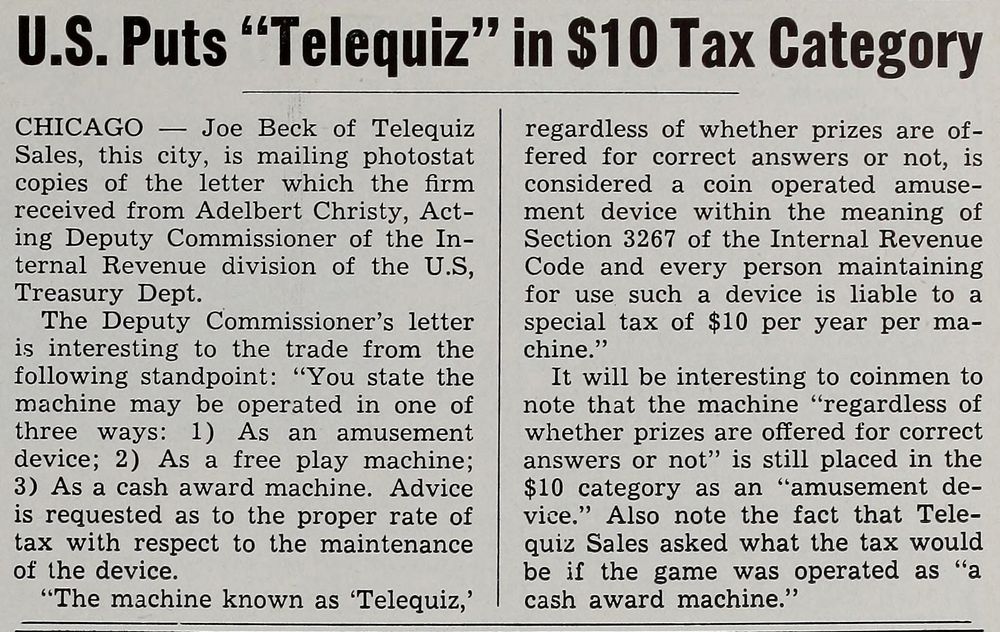
1946-09-02 Cash Box pg 53. Clarifying article on the tax-back status of Telequiz.

1947-03-17 Life pg 144. A woman plays a Telequiz, featured in Life Magazine.
Oddly, the game even received somewhat of an endorsement by the powers that be.
The IRS had instituted a $10 tax credit on coin-operated devices for operators and Telequiz was advertised with that fact.
Interest in the device reached outside of the traditional coin-op industry.
30.09.2025 22:36 — 👍 4 🔁 1 💬 1 📌 0

1945-09-09 Star Tribune (Minneapolis) pg 4. Thomas Sisson with the early version of the Telequiz machine.

1946-08-12 Cash Box pg 39. Advertisement for Telequiz asking for distributors, once again emphasizing its legal status.
Sisson had learned a lot from his first time around.
One of Telequiz's biggest draws was its legality. With a Navy pedigree and no way to rank up free plays, Training Devices was confident that Telequiz would not face issues with the law in this new age.
30.09.2025 22:34 — 👍 4 🔁 1 💬 1 📌 0

1946-12 The McGraw-Hill Digest pg 20. A man plays a Telequiz machine.
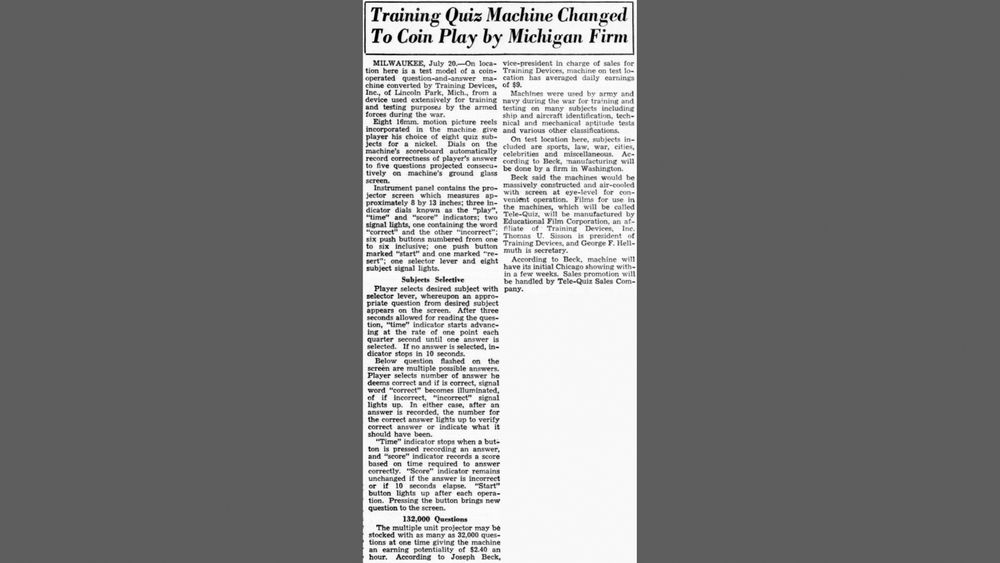
1946-07-27 Billboard pg 115. Announcement of the Telequiz machine to the coin-op press.

1946-07-22 Cash Box pg 51. First advertisement for the Telequiz machine, emphasizing its status as a post-War, legal machine.
The company started testing the machine in locations around the Midwest, charging a nickel for five questions in 13-second time increments.
In July 1946, the machine was introduced to the coin-op industry as Telequiz: A new type of game for the post-War world.
30.09.2025 22:32 — 👍 4 🔁 1 💬 1 📌 0
YouTube video by Chad Matthis
Amusing Educational Telequiz
The film strip was much better than the previous card system. Now the device could hold thousands of questions, featuring a range of categories including sports, civic events, and pop culture.
(Video shows the later, but similar, model in action)
www.youtube.com/watch?v=Ni3x...
30.09.2025 22:29 — 👍 4 🔁 1 💬 1 📌 0
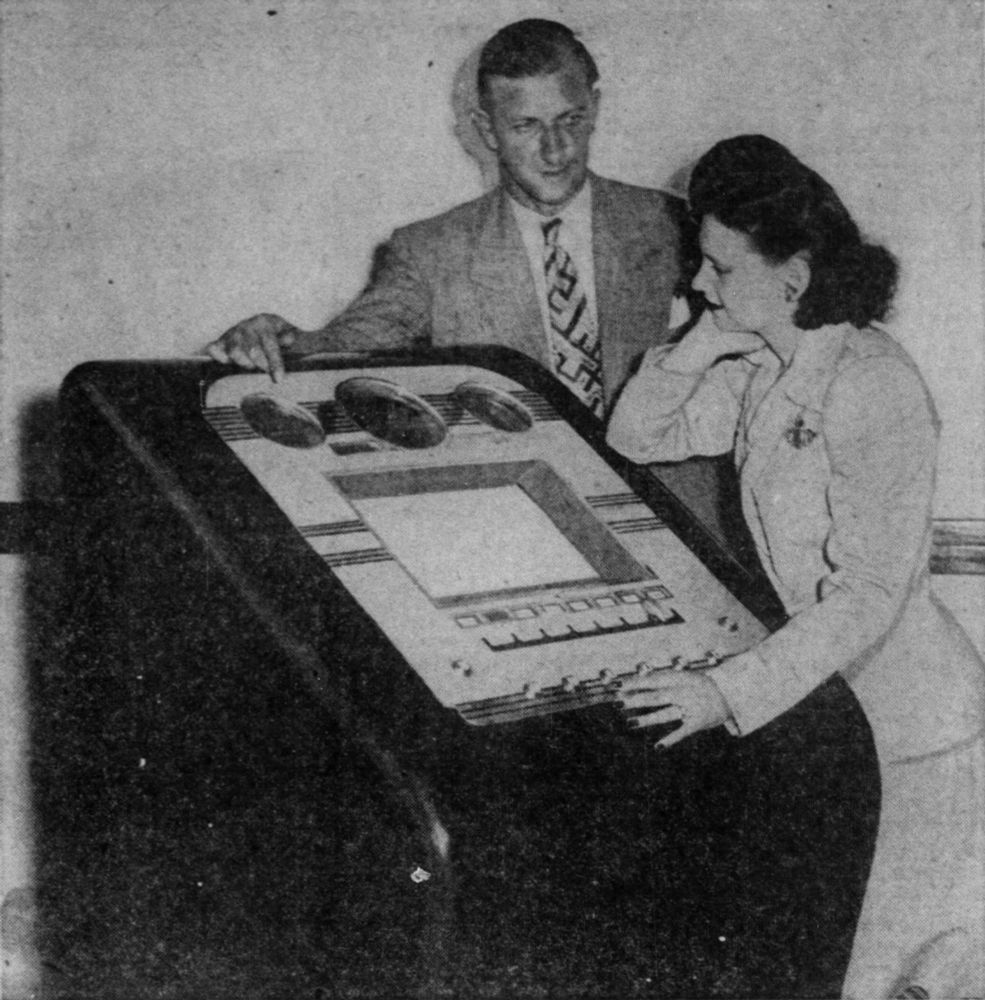
1945-09-02 Detroit Free Press pg Part 2 3. Thomas Sisson demonstrates the newly redesigned quiz device to a woman.

1945-09-09 Star Tribune (Minneapolis) pg 4. Profile on the operation of Sisson's quiz device.
Thomas Sisson was not about the let the potential go to waste.
As the war started winding down, he founded a new company called Training Devices Inc. in Michigan to once again tap into the coin-op industry.
He improved the game, introducing 16mm film and eight projectors to display the questions.
30.09.2025 22:28 — 👍 4 🔁 1 💬 1 📌 0

1945-02-02 The Buffalo News pg 27. Two Naval personnel demonstrate the Automatic Rater.

1945-07-17 Chicago Tribune pg 11. A near-end of War Naval showcase with Automatic Rater machines on display.

1945-08-31 The Press Democrat pg 3. Both Link trainers and Automatic Rater machines being shown as products of the electronic industry during the war.
Were they actually effective teaching tools? That I couldn't find. (One of the Navy archivists)
After the war, the Automatic Rater was showcased by the Navy in exhibitions as an example of electronic technology from the war – alongside the likes of the Link Aviation trainers.
30.09.2025 22:25 — 👍 4 🔁 1 💬 1 📌 0

1944 US Naval Training Bulletin pg 33. Naval recruits at orientation try out the Automatic Rater.
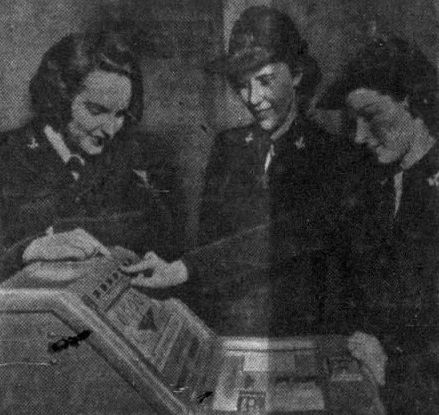
1945-01-18 Lancaster Enterprise pg 8. Women at the Navy Training School try Automatic Rater.

1945-01-21 The Courier-Journal pg Section 1 13. An article on the Automatic Rater's use in Navy training.
The Automatic Rater was a great success. Trainees and service people found them amusing - often comparing it to pinball with its scoring system.
Over 1,500 of them were built throughout the War and they even received additional question packs.
30.09.2025 22:23 — 👍 4 🔁 1 💬 1 📌 0

1943-06-28 Life pg 50. Demonstration photo of the Automatic Rater, comparing it to a pinball machine.

1943-07 Air Force pg 37. Formal announcement by the Navy of the Automatic Rater.

1944 US Naval Training Bulletin pg 42. A collection of Navy men train at the Automatic Rater.
The device was rejiggered as the Automatic Rater as part of the Naval Aviation Training Division.
It was simplified - only requiring users to select from multiple choices with buttons. The chief aim was to test identification of enemy aircraft, but other subjects were also available.
30.09.2025 22:21 — 👍 4 🔁 1 💬 1 📌 0

1942-06-19 Daily News (New York, New York) pg M6. A cadre of Naval officers stand around the redesigned Automatic Rater machine.

1945-09-02 Detroit Free Press pg Part 2 3. Snippet from a profile of Sisson about how the device first came to the Navy's attention.

1942-06-18 The Flint Journal pg 6. A nationally reported news snippet about the quiz machine project for the Navy.
As U.S involvement in World War II began, Sisson instead turned to the Navy.
Apparently on a whim, he mentioned his old device which could supposedly rate intelligence by speed of reply.
Soon the Navy picked up the device as an official training project - which made national news.
30.09.2025 22:18 — 👍 4 🔁 1 💬 1 📌 0

1941-02-08 Billboard pg 77. Article about the Dr. I.Q. machines winning an appeal for legality in Mississippi.

1941-10-08 Birmingham Post-Herald pg 18. Dr. I.Q. loses an appeal for legality in Florida and is labeled a gambling device.
Sisson initially tried to sell these machines in his home state of Mississippi under the name Dr. I.Q.
However, he immediately ran afoul of anti-pinball laws. While he won an appeal at home, in Florida his game was declared a gambling device.
30.09.2025 22:15 — 👍 5 🔁 1 💬 1 📌 0

Second page from US Patent #2,274,811 showing the reel of material displaying the questions.
https://patents.google.com/patent/US2274811A/

Figure from the third page of US Patent #2,274,811 demonstrating the perforation system.
https://patents.google.com/patent/US2274811A/
The game ran on a timer and detected your answer using perforated holes on the side of each display – like punched cards or piano rolls. If the right keys were pressed, you succeeded.
This method was later used in film-based games like Auto Test and Wild Gunman (though this may have been paper).
30.09.2025 22:13 — 👍 5 🔁 1 💬 1 📌 0

1946-08-26 Cash Box pg 51. Portrait photo of Thomas U. Sisson.

Image of the coin-operated quiz device from US Patent #2,274,811.
https://patents.google.com/patent/US2274811A/
But here's what's weird... There are many parallels of this to a coin-op device from around 20 years earlier.
Thomas U. Sisson was a lifelong Navy enlistee who in 1939 patented a coin-operated device featuring a keyboard and a window featuring questions - stored on a loop of material.
30.09.2025 22:10 — 👍 4 🔁 1 💬 1 📌 0

Knowledge Computer sales sheet, c. 1964 from the Alexander Smith Nutting Associates collection at the Strong Museum of Play.
https://romchip.org/index.php/romchip-journal/article/view/175

The B. F. Skinner Teaching Machine, built circa 1957.
https://americanhistory.si.edu/collections/object/nmah_690062
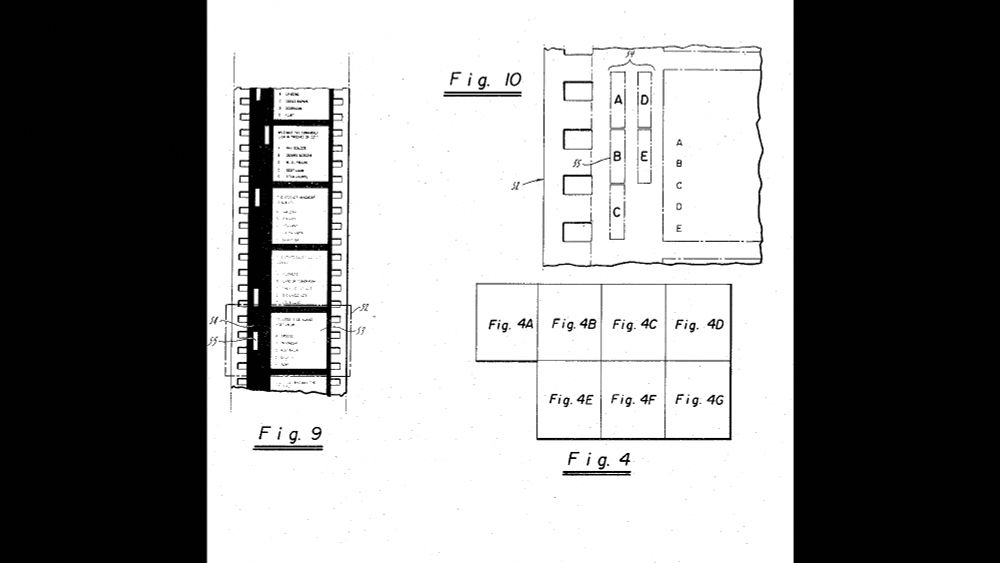
Image from US Patent #3,399,875 regarding the Knowledge Computer.
https://patents.google.com/patent/US3300875A/
Edex Corp was established to create "teaching machines" for the education market, a concept traditionally dated back to an invention by B. F. Skinner in 1957.
Engineer Thomas Nisbet of Edex created Knowledge Computer seemingly on a whim - for a company not involved in coin-op games.
30.09.2025 22:07 — 👍 4 🔁 1 💬 1 📌 0

1966-03-09 Montana Kaimin pg 1. Students play a Knowledge Computer at the University of Montana.

1964-07-08 Oakland Tribune pg 17. Article about a halted pinball ordinance featuring the Knowledge Computer.
It was placed in train stations, bowling alleys, and even student unions which typically rejected games like pinball.
In one California county, the game was even responsible for stalling a local pinball ban.
For the insular coin-op industry, Knowledge Computer was a respectable spokesman.
30.09.2025 22:00 — 👍 5 🔁 1 💬 1 📌 0

Full view of a Knowledge Computer machine.
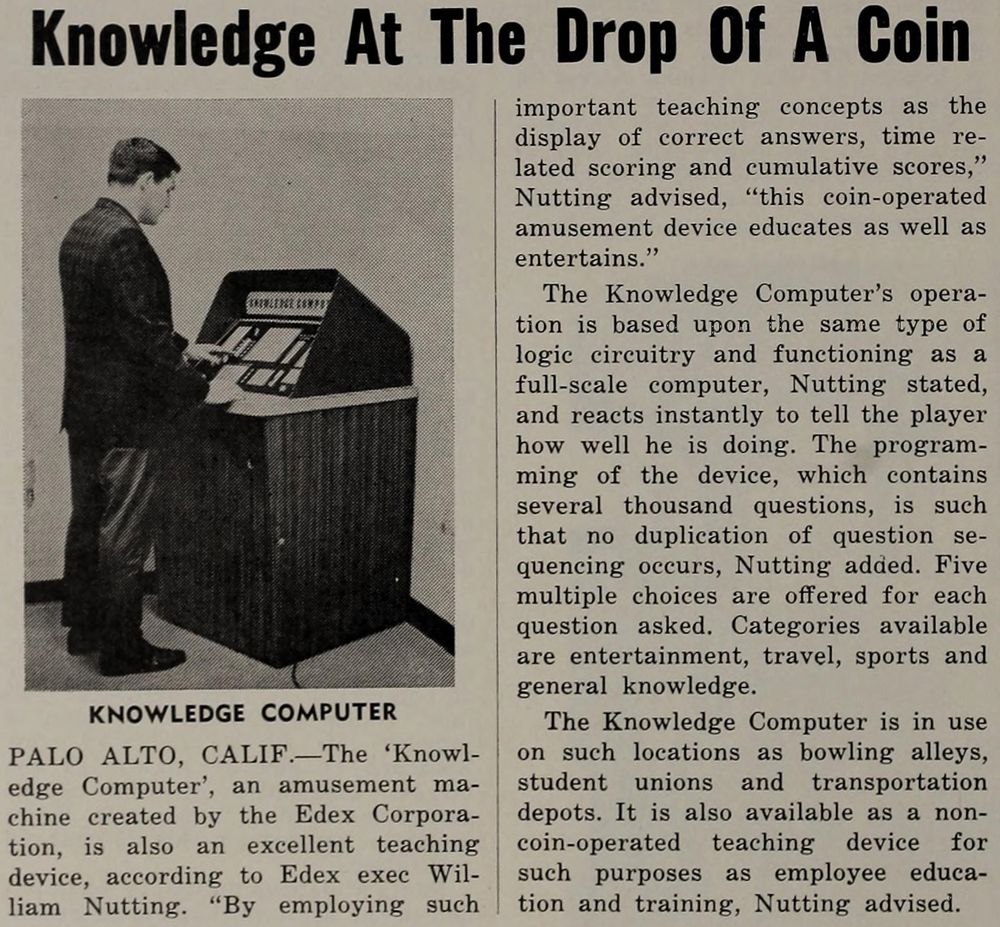
1964-08-22 Cash Box. Announcement of Knowledge Computer with commentary by Bill Nutting.
Bill Nutting had served as the agent for the Knowledge Computer for a number of years, before his desire to have it redesigned created Computer Quiz and I.Q Computer.
Though not hugely successful, Knowledge Computer was noted for having a reach beyond a typical coin-op machine.
30.09.2025 21:58 — 👍 5 🔁 1 💬 1 📌 0

Console view of the Knowledge Computer.

1964-10-31 Billboard. The Knowledge Computer shown at the 1964 MOA show, under the name Scientific Amusements which was used for marketing the device.
The question is not about which machine was first: Both games had the same origin point.
In 1963, Edex Corp had started marketing the Knowledge Computer to the coin-op industry. It featured the key elements of both quiz games, but in a less refined form factor.
30.09.2025 21:56 — 👍 5 🔁 1 💬 1 📌 0

1968-02-17 Cash Box pg 74. Bill Nutting in his office.
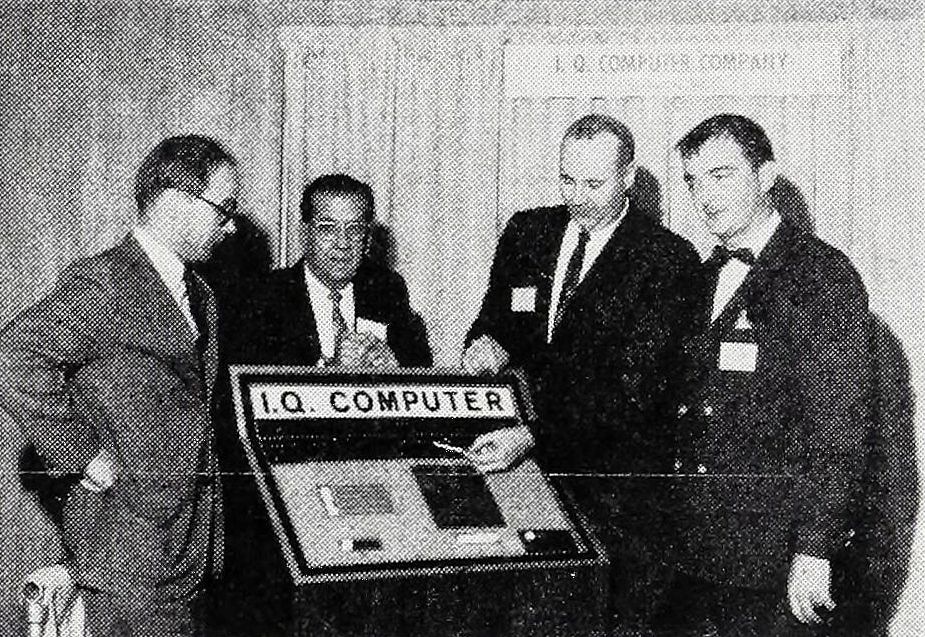
1967-11-11 Cash Box. Dave Nutting (far right) with the I.Q. Computer machine.
Of course, these similarities were no coincidence.
Brothers Bill (Nutting Associates) and Dave (Nutting Industries) had originally been working towards the same goal.
As a result of far-too-complicated machinations, they went their separate ways and created a quiz game market.
30.09.2025 21:53 — 👍 5 🔁 1 💬 1 📌 0
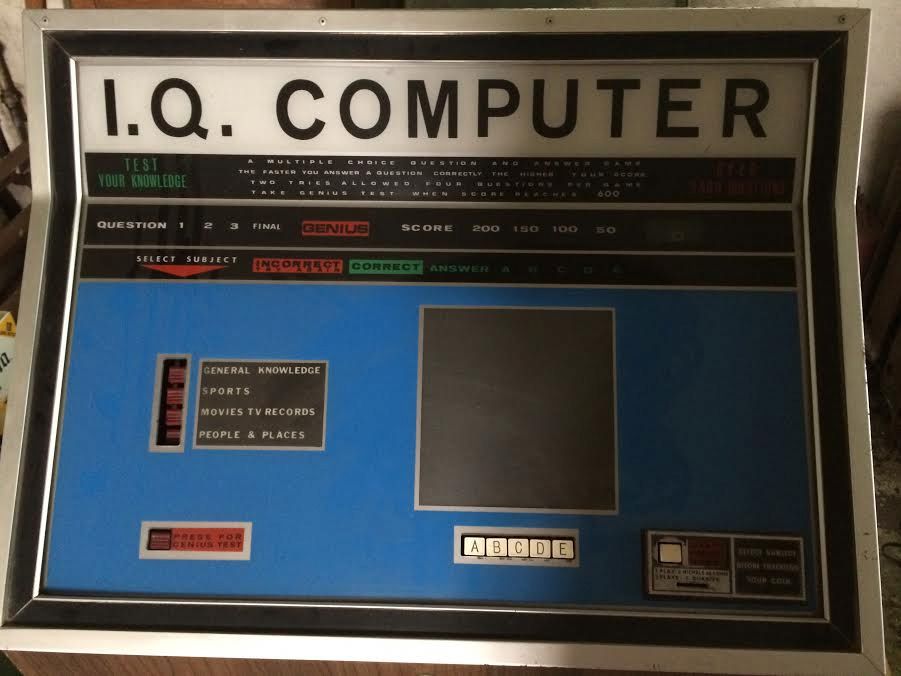
Close-up of the console for I.Q. Computer.
https://forums.atariage.com/topic/227253-help-nutting-industries-ltd-iq-computer/

1967-07-19 The Orlando Sentinel pg Osceola-Polk 02. A child stands in front of an I.Q. Computer machine, pouting.

Front page of an operation manual for I.Q. Computer.
However, Computer Quiz was not alone.
Simultaneously developed and sold, I.Q. Computer by Nutting Industries in Wisconsin had its own mix of quizzical trivia.
While less successful than Computer Quiz, it forged its own path in a rapidly altering coin-op market.
30.09.2025 21:47 — 👍 6 🔁 1 💬 1 📌 0




































































